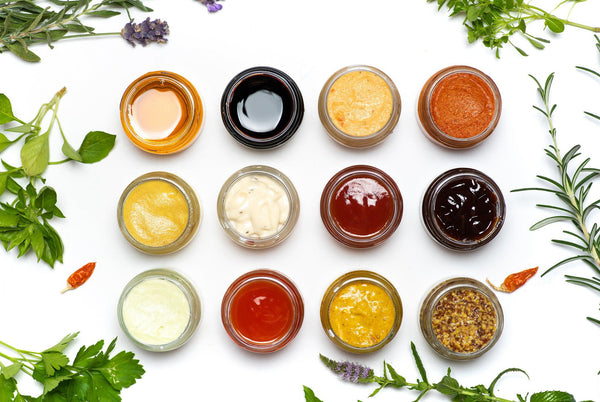
Jump to:
Asian cuisine is celebrated for its complex flavors, much of which comes from the diverse range of sauces used in cooking. These sauces can transform simple ingredients into extraordinary dishes with just a dash of flavor. From Japanese to Chinese and Thai, these sauces add depth, umami, and a hint of sweetness or spice to your meals.
In this article, we’ll explore some of the best Asian sauces that can elevate your home cooking to the next level.
1. Shoyu (Soy Sauce)
If Asian cuisine had a mascot, it’d probably be a bottle of soy sauce (sorry, sriracha devotees, that one’s cute but it isn’t big everywhere). Known as shoyu in Japan, this dark, salty sauce is the OG of savory Asian cooking, adding depth and that irresistible umami flavor to countless dishes across the continent.
Here are some types of shoyu:
-
Koikuchi Shoyu: Often referred to as dark soy sauce, koikuchi shoyu is rich and full-bodied, making it ideal for both seasoning and as a condiment. Aged in traditional barrels, it develops a complex aroma and depth of flavor, enhancing everything from stir-fries to marinades.
-
Usukuchi Shoyu: Lighter in color but not in flavor, usukuchi shoyu provides a subtle taste that elevates dishes without overwhelming them. It’s commonly used in Japanese cooking, especially in delicate preparations where you want to add saltiness without altering the dish’s appearance.
-
Saishikomi Shoyu: Known for its rich, deep flavor, saishikomi shoyu undergoes a double fermentation process, creating a complex flavor profile that can resemble fine wine. This type of soy sauce has a mild saltiness and is perfect for pairing with dishes like sashimi and chilled tofu (hiyayakko).
-
Shiro Shoyu: Shiro shoyu, or white soy sauce, is a lighter, slightly sweet variety made with a higher proportion of wheat than soybeans. Its pale color makes it ideal for dishes where you want to maintain a light appearance while adding flavor, such as in salad dressings or seafood dishes.
-
Tamari: A gluten-free option, tamari is made primarily from soybeans, often with little or no wheat. It has a richer and more complex flavor than regular soy sauce, making it an excellent choice for dipping sauces and marinades.
-
Sweet Soy Sauce: This sweetened soy sauce is perfect for glazing grilled meats, enhancing egg dishes, and adding richness to stir-fries.
2. Teriyaki Sauce
Teriyaki sauce is a sweet and savory staple in Japanese cuisine, and its influence extends well beyond Japan. Typically made from soy sauce, mirin (sweet rice wine), sake, and sugar, this sauce adds a glossy finish and rich flavor to grilled or pan-fried dishes.
“Teriyaki” refers to the cooking method where food is grilled or broiled with a soy sauce glaze. Teriyaki sauce is versatile, commonly used as a marinade for meats and fish or as a glaze. Its perfect blend of sweetness and savory umami makes it a favorite for many.
For those seeking authentic teriyaki flavor, this teriyaki sauce is an excellent choice. Ready-to-use, it has a perfect balance of sweetness and umami, ideal for marinating chicken, beef, or salmon before grilling. Ebara’s teriyaki sauce also works well as a glaze during cooking or even as a dipping sauce. Want to try making teriyaki sauce at home? We’ve got a recipe for teriyaki chicken.
3. Fish Sauce
While not as commonly used in Japanese cuisine as in other Asian cuisines, fish sauce still finds its place in certain regional dishes. In Japanese cooking, fish sauce is typically used in small amounts to elevate the flavors of soups, stews, and marinades. Due to its concentrated taste, a little goes a long way.
This fish sauce offers a unique and delicate take on traditional fish sauces. Made from flying fish, this Japanese fish sauce has a milder flavor compared to the stronger, more pungent Southeast Asian varieties. It’s perfect for adding a subtle umami boost to Japanese dishes without overpowering other ingredients.
For those who prefer a more intense and complex flavor, this gluten-free fish sauce made from squid packs a bold umami punch that is perfect for enhancing soups, stews, and other hearty dishes. Its rich taste truly shines when used in dishes that benefit from deep, savory flavors.
4. Sweet Soy Sauce
Sweet soy sauce, also known as kecap manis, is a thick, dark sauce with a molasses-like flavor. It is commonly used in Indonesian and Malaysian cuisines to add a sweet and savory depth to dishes. This sauce is perfect for glazing meats, adding to stir-fries, or as a dipping sauce. Additionally, combining sweet soy sauce with sesame oil can enhance the flavor of stir-fries and marinades, making them more aromatic and rich.
5. Oyster Sauce
Oyster sauce is a thick, dark brown sauce made from oyster extracts, soy sauce, and sugar. Known for its rich, savory-sweet flavor, it’s popular in Chinese and Japanese fusion cooking. Used in stir-fries, marinades, and as a vegetable seasoning, it adds depth and a glossy finish to dishes. Start with small amounts to avoid overpowering flavors.
This high-quality option is made with premium oysters, offering a deep, savory flavor perfect for stir-fries or as a finishing sauce for vegetables. Its rich taste can elevate any dish, making it a must-have for anyone looking to incorporate authentic Japanese oyster sauce into their cooking. For an extra layer of flavor, consider adding red pepper flakes to give the sauce a spicy kick that complements its sweetness and tanginess.
If you are looking for an oyster sauce substitute that’s suitable for vegan, vegetarian, Halal, or Kosher diets, check out our article on alternative recipes for oyster sauce.
6. Brown Sauce
In Japanese cuisine, several types of brown sauces are popular, each adding its own unique flavor.
-
Okonomiyaki sauce is thick, sweet, and savory, used on the Japanese pancake, okonomiyaki, and similar to Worcestershire sauce but sweeter.
-
Takoyaki sauce is a thinner variant, used on takoyaki, the famous octopus-filled snack.
-
Japanese Worcestershire sauce has a sweeter, fruitier flavor than its British counterpart, and it's a key ingredient in Western-influenced dishes like hambagu.
-
Chuno sauce is semi-sweet and thick, perfect for tonkatsu (fried pork cutlet) and other fried dishes.
These sauces bring a tangy, sweet richness to dishes and are versatile as condiments or cooking sauces. Want to dive deeper? Check out our article on Japanese brown sauces.
7. Mayonnaise
While mayonnaise may not seem traditionally Asian, Japanese mayo has become a beloved staple in many Japanese homes and restaurants. What sets it apart is its richer, creamier texture, thanks to the use of egg yolks rather than whole eggs. Japanese mayo also has a tangier, slightly sweet flavor compared to Western versions.
It's used in a variety of ways: as a condiment for fried foods, a spread for sandwiches, a base for salad dressings, and even in cooking. Popular dishes like takoyaki and okonomiyaki wouldn't be the same without it.
Kewpie mayo is the gold standard in Japan. Known for its rich, creamy texture and umami punch, it’s incredibly versatile—great as a dip, spread, or dressing base.
Curious to make your own? Check out our article on how to create a simple Japanese-style mayonnaise.
8. Ponzu Sauce
Ponzu is a citrus-based sauce widely used in Japanese cuisine. Made by combining citrus juice (typically yuzu, sudachi, or lemon) with soy sauce, mirin, and dashi, it offers a tangy, savory flavor with a refreshing citrus note.
This versatile sauce is commonly used as a dipping sauce for sashimi and shabu-shabu, a dressing for salads, or a marinade for grilled meats and vegetables, adding a bright, zesty touch to many dishes.
We highly recommend this premium ponzu sauce, featuring a blend of sudachi and yuzu, delivers a complex, well-balanced flavor that enhances sashimi, grilled fish, or simple salads.
For those who enjoy a bit of heat, this spicy ponzu sauce combines the traditional citrus tang with a spicy kick from green peppers, perfect for adding zest and heat to your dishes.
9. Unagi Sauce
Unagi sauce, or eel sauce, is a thick, sweet sauce commonly used in Japanese cuisine, primarily for glazing grilled eel (unagi). Despite its name, it doesn't contain eel; instead, it's made from soy sauce, mirin, sake, and sugar—Japanese staples.
With a rich, savory-sweet flavor, unagi sauce complements grilled eel and other grilled foods, often used as a glaze for fish or chicken and as a flavoring for rice bowls. It adds a glossy finish and a burst of flavor to dishes, balancing the strong flavors of fish or enhancing the depth of vegetable dishes.
10. Goma Dare (Sesame Sauce)
Goma dare, or sesame sauce, is a creamy, nutty sauce primarily made from ground sesame seeds, along with soy sauce, mirin, rice vinegar, and sometimes sugar or honey.
This sauce boasts a rich, creamy texture and deep, nutty flavor with a hint of sweetness. It's commonly used as a dipping sauce for shabu-shabu (Japanese hot pot), a dressing for salads, or a sauce for cold noodle dishes.
This sesame sauce has a creamy texture and pronounced sesame flavor make it perfect for salads, raw vegetables, or grilled meats. Drizzle it over steamed vegetables or use it as a marinade for chicken to enhance your dishes.
If you find goma dare too sweet for some dishes, try adding hot sauce or chili oil to spice things up!
11. Sweet Chili Sauce
Sweet chili sauce, often linked to Thai cuisine, has gained popularity in various Asian-inspired and fusion dishes. Typically made from red chili peppers, garlic, sugar, and vinegar, it offers a sweet and spicy flavor profile.
This versatile sauce can serve as a dipping sauce for spring rolls and fried foods, a glaze for grilled meats, or a flavor enhancer in stir-fries. Its perfect balance of sweetness and heat makes it a crowd-pleaser in many recipes.
Asian Sauces: Your Kitchen's Versatile Sauce Essentials
These Asian sauces offer a delightful array of flavors that can elevate your cooking and impress friends and family. From the umami-rich soy sauce and tangy ponzu to the sweet-savory teriyaki and creamy goma dare, each sauce contributes its unique character to Asian and Asian-fusion dishes.
Do you have a favorite Asian sauce that you love to cook with? Share it with us in the comments below!













0 comments